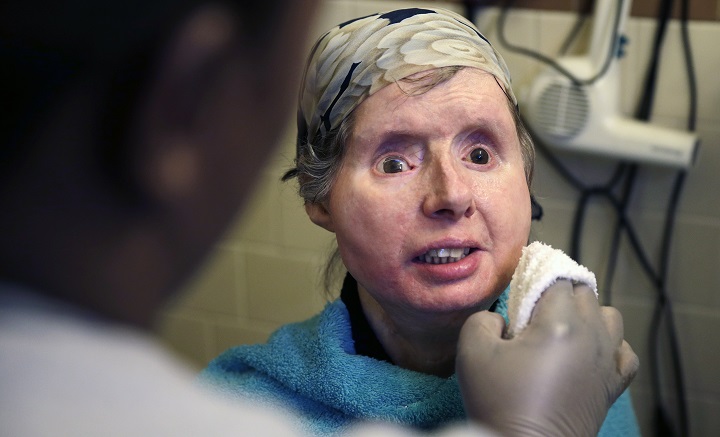BOSTON – Charla Nash never served in the military. She was horribly disfigured, not in combat, but in a 2009 attack by a rampaging chimpanzee. The Defence Department, though, is watching her recovery closely.

The U.S. military paid for Nash’s full face transplant in 2011 and is underwriting her follow-up treatment at a combined cost estimated in the hundreds of thousands of dollars, in the hope that some of the things it learns can help young, seriously disfigured soldiers returning from war.
In the coming weeks, for example, Nash will take part in a military-funded experiment in which doctors at Boston’s Brigham and Women’s Hospital will try to wean her off the anti-rejection drugs she has been taking since the transplant.
Nash jokes about sometimes feeling like a science project. But the 61-year-old daughter of an Air Force veteran said she gets real satisfaction out of letting the doctors use her for research, and sees it as an opportunity to help wounded soldiers and “do something good out of all of this bad.”
“They asked me, could they? I said, ‘Yeah, I’d be thrilled to help out in any way I could,”‘ said Nash, a former Connecticut resident who now lives on her own in Boston with the help of part-time aides.
Nash lost her nose, lips, eyelids and hands when she was mauled by her employer’s 200-pound (90-kilogram) pet chimpanzee in Stamford, Connecticut. Doctors also had to remove her eyes because of a disease transmitted by the chimp.
She later received new facial features taken from a dead woman. She also underwent a double hand transplant, but it failed when her body rejected the tissue.
Now blind, Nash spends most of her days listening to AM radio and books on tape – lately, “War and Peace” – in her modest, second-story apartment. She also exercises a couple of days a week with a trainer at a gym to build her strength and stay healthy. A GoFundMe account is being set up to help raise money for prosthetic hands.
Her life today is a stark contrast to her younger years, when she was a barrel racer on the rodeo circuit from the 1970s through the mid-1990s. Over the years, she also did some horse-jumping, worked on a farm and manned a computer help desk. She was working as a dispatcher for a towing company at the time of the attack.
About every six weeks, Nash undergoes lab tests for the military at Brigham and Women’s. She is also subjected to MRIs and CT scans to determine how well her brain is sending signals to her new face. In addition, doctors examine how well the arteries are delivering blood to the transplant.
The military is also interested in such things as any scarring around the mouth and how well her eyelids work.
“It makes sense for us to look at the civilian community and the experiences that are gained through the involvement of non-uniformed people to assess if this is a good solution for the military,” said Dr. Brian Pfister, a portfolio manager for the U.S. Army Medical Research and Materiel Command’s Clinical and Rehabilitative Medicine research program.
About 35 full or partial face transplants have been performed worldwide since the first one was done in France in 2005. The Defence Department estimates 560 soldiers have suffered severe facial wounds in Iraq and Afghanistan. Of those, about 50 or 60 might be candidates for a face transplant, Pfister said.
The Pentagon is providing grants to 14 medical facilities across the U.S. through its hand and face transplantation program. The face and the extremities are the two most frequently injured parts of the body in war.
The new experiment, involving the suspension of anti-rejection drugs, will eventually include other patients, and its findings could potentially affect hundreds of thousands of people, military and civilian alike, doctors said.
The immunosuppression drugs that transplant patients are typically given for the rest of their lives carry such risks as cancer, viral infections and kidney damage. Because of those dangers, many transplants of non-vital body parts, such as thumbs, are not considered worth doing.
But that could change if the drugs don’t have to be a lifelong commitment.
“Suddenly, it’s not as crazy to think about transplanting individual fingers or an ear,” said Dr. Bohdan Pomahac, who led Nash’s transplant surgery team.
Nash will be switched to a different substance, Interleukin-2, which is normally used to treat skin and kidney cancers. The hope is that it will promote growth of good cells that protect the transplant while attacking those that want to reject it.
Pomahac said Nash is doing “remarkably well” and has experienced very few rejection episodes, making her a good candidate for the experiment.

Comments